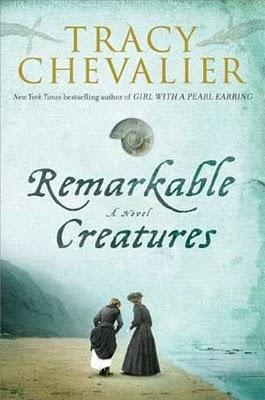Remarkable Creatures

I'm a huge fan of Tracy Chevalier. Like a lot of people, I began with Girl with a Pearl Earring, and have since made my way through all but one of her other books. So of course I leapt at the chance to sample her newest offering.
Like all her books, Remarkable Creatures begins with something tangible. In Pearl Earring it was a Vermeer painting, and The Lady and the Unicorn explained the origin of a famous medieval tapestry. This time, the inspiration is a sketch of a most unusual woman.
Mary Anning is a working class girl living on the southern coast of Britain. The people there often host tourists and sell them "curies," curiosities, as souvenirs. Only recently have men of learning begun to study and classify these curies as fossils. Mary has "the eye" for spotting them, and she is keeping her family afloat by hunting fossils along the beach.
An older gentlewoman and spinster, Elizabeth Philpot, takes an interest in this clever girl. She, too, collects fossils. They form a friendship, spending hours and hours together combing the beach and cliffs for new specimens. Elizabeth collects for the joy of it, Mary for the money.
Everything changes when Mary discovers a "monster"—an Ichthyosaurus preserved in the rock. Educated men swarm to the town to see it for themselves and try to discover their own creatures. Mary is pleased by the attention and works closely with the men to find each his own specimen. Though they are only too happy to gain from Mary's knowledge and experience, Elizabeth discovers that Mary's best specimen is not credited to her at all; instead, the man who sells it to the London museum is listed as its discoverer.
Elizabeth is dismayed when she realizes how badly Mary is being abused. Collectors and scientists are appropriating all her efforts, so she spends less time collecting items to sell. One man even draws Mary into a flirtation and takes advantage of her desire to please him. He leaves town with nearly a hundred specimens—and not a dime to pay Mary for fossils or guidance.
The facts Chevalier has based the book on bear this out. The real Mary Anning and Elizabeth Philpot were hardly acknowledged in any official capacity by their contemporaries. Mary is and was responsible for discovering the first complete skeletons of several dinosaurs, but it is the men who purchased them to study at schools and museums who named them and whose names are now remembered.
Though Mary is doing sensational things, it is Elizabeth who is really exceptional. She is very self-aware, and is under no illusions about her future. Her family has only enough money for one of four sisters to marry, and that sister is not her. She knows she will need something to occupy her days. She chooses fossils. She reads scientific journals voraciously, and she is constantly seeking answers to questions many people—including the foremost natural scientists of the day, all men—avoid: What are these fossils? Why do these animals no longer exist? Did God allow them to die out? Did he destroy them—did God make a mistake in their creation? Could humanity die out one day? What a majority now consider hard facts were then shocking, blasphemous ideas to nearly everyone.
Remarkable Creatures speaks of both the amazing fossils being uncovered and the two women who pursue an unladylike career with no hope of recognition. The world they live in shapes their actions and reactions, turning what could be a dull history into a vibrant story of female friendship. An excellent read for the drizzling, gray days you want to spend indoors.